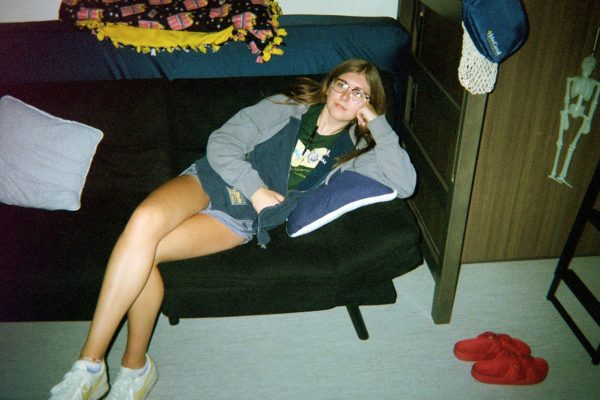What do an NBC News video truck toy, a Golden Plate award and Democratic & Republican baked beans have in common? These unexpected objects are all artifacts that make up the Tim Russert archive, now on display in an interactive website entitled “Tim Russert: One Man’s Impact on the Nation.”
On Oct. 3 in the Donahue Auditorium, the official launch party for the digital exhibition took place with special insights from former NBC Correspondent Pete Williams as well as University Board Member and friend of Russert, Linda Meglin ’74.
Malia McAndrew, who holds a doctorate in United States History, played an integral role in the development and documentation of this momentous endeavor. For three semesters, over 50 students who were enrolled in her United States History After 1945 course assisted in the curation of the exhibit and digital chronologically. With over 156 linear feet of materials donated by the Russert estate, the task of organizing and documenting each object was no small feat.
When asked about this process, McAndrew said, “We worked with two professional organizations to help advise, consult and work with us. History Associates Incorporated (HAI) based out of Maryland and the Axiel Group which is actually a Swedish company.”
With so much material to process, McAndrew credited HAI with helping the team consulate and recognize what objects deserved a place in the collection. “We had multiple meetings with the students to talk through what are the narrative points. One of the things I really appreciated about that is that the students who are a part of this project got to work with industry leaders which is really a pre-professional experience.”

Emilee Riddell ’25 worked alongside McAndrew and reflected, “I was skeptical about finding work that involved both history and technology, but this experience showed me that it’s possible. I believe honing one’s technological skills is extremely important in this day and age….I was skeptical about finding work that involved both history and technology, but this experience showed me that it’s possible. I believe honing one’s technological skills is extremely important in this day and age.”
The presentation of the collection was narrated by Emma Arrighi ’25, Lauren Seibel ’26 and Cody Patton ’28, who introduced the three main sections of the interactive exhibit: Strong Foundations, Meet the Press and Beyond the Studio.
Housed within each of these pages are clips, photographs and memorabilia that tell the story of Russert’s life in his hometown of Buffalo NY, his time at JCU and significant moments on-air as the longest-running moderator of “Meet the Press.”
Arrighi introduced the portion of the collection on Russert’s time at JCU where he served as president of the University Club and the Student Union. “Through these organizations, he advocated for student rights and booked entertainment acts including The Beach Boys and Muhammad Ali. After graduating, he continued to help the school by booking a little-known musician named Bruce Springsteen.” Attendees of the event were shown images of the Russert Collection which includes photos of his presidential campaign material on trash cans and signage.
Later, Luke Russert, son of Tim Russert, prepared a video message to share his thoughts on the launch of his father’s public collection. He said his father’s time at John Carroll “was one of the fondest experiences of his life. He believed in so much in order to achieve the common goal… Going up against some of the smartest, and having the Jesuit Approach was very impactful.”
Luke Russert shared an anecdote about his father’s time working in politics before transitioning to the journalism field. “Before he got into TV, he did a stint in politics and one thing that Senator [David] Moynihan said to my father was… ‘Well you know Tim, what they have you can learn, but what you have they will never learn.’ And those are the values of a John Carroll education.”

After the presentation of the website, Meglin fielded questions from students regarding Russert’s impact on the JCU community during a time of immense turmoil in the late 1960s and early 1970s. When asked about remembering him as a student, Meglin said, “I miss him so much. This reminded me of his eyes, his charm, his deliberate way of asking questions and memories.”
Williams reiterated the uniqueness of Russert’s interviewing style, adding, “Working in the Defense Department, the bureau chiefs would call me. Russert was the only one to ask substantive questions.”
To access the Tim Russert Collection, click here.



